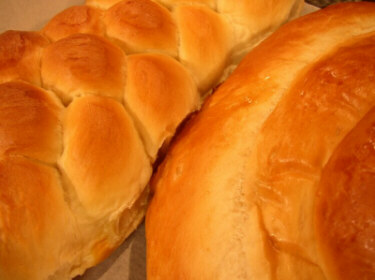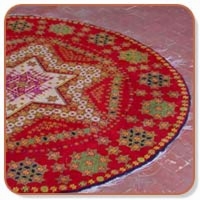
There I was at the bookstore, furtively eyeing lush chicken legs, decadent almond tortes, glistening honey cakes, and sensuous strands of challah. My senses were titillated, my juices running, all from the images in these books. How could I have come to this? As the founding editor of Gastronomica, I used to avoid those cookbooks that bare themselves so flagrantly. I’d bypass the glossy coffee table volumes for informative, if visually lackluster, tomes like Matthew Goodman’s Jewish Food or Susan Friedland’s Shabbat Shalom. I was dearly hoping that no one I knew would discover me drooling over all this gastroporn.
So what was I doing here, surreptitiously salivating over these picture books with their simplistic recipes and lack of explanatory text? The answer lay thousands of miles away, in a small Jewish community in Ashgabat, the capital of Turkmenistan, the intended destination (via the local branch of the Jewish Agency for Israel) of the cookbooks. The Jewish Agency provides moral and some financial support for the few remaining Turkmen Jewish families, struggling to establish a Jewish identity in a country that officially sanctions only Islam and Russian Orthodoxy. It’s not easy. Ever since Turkmenistan gained independence in 1991, President Saparmurat Niyazov, aka Turkmenbashi (Head of All Turkmens), has ruled the country with an increasingly iron fist. The only way that the Jewish community in Ashgabat can even gather is as an officially registered cultural, not religious, organization. Because of such difficulties The Jewish Agency has encouraged most Turkmen Jews to emigrate to Israel, but a small group has chosen to stay in the country of their birth.
I had come to Ashgabat to visit an old college friend, who was finishing her term as the US mbassador to Turkmenistan. Even with my friend’s pull it took months to get a visa, and I was allowed to come only as an official guest, an authority on food and culture and the ways in which they intersect. Besides having edited Gastronomica, I am also the author of cookbooks on Russian and Georgian cuisines, so I was not uncomfortable with this persona, and it allowed my hosts to arrange a full program of visits to Ashgabat’s various ethnic communities so that I could learn about their distinctive foodways. In return, I offered a master class on the preparation of blini, gave a lecture on Russian cuisine, and spoke with a group of Turkmen students about regional American foods and the new field of food studies.
 Of all the groups I visited, including Turkmen, German, and Kazakh, the Jews struggled most with questions of identity. Unlike other Jewish communities throughout the world, the Ashgabat Jews don’t yet share in a larger sense of Jewish history. Their connection with Jewish identity is made difficult not only because of government control and lack of ready access to information, but also because most of the active members of the community are young and middle-aged mothers, the children of Jews displaced from western Russia, especially Ukraine, under Stalin. These Soviet Jews, even if culturally Jewish, were not at all religious, and so they did not bring a tradition of Judaism with them. Thus the younger generations of Turkmen Jews have no foundation on which to build.
Of all the groups I visited, including Turkmen, German, and Kazakh, the Jews struggled most with questions of identity. Unlike other Jewish communities throughout the world, the Ashgabat Jews don’t yet share in a larger sense of Jewish history. Their connection with Jewish identity is made difficult not only because of government control and lack of ready access to information, but also because most of the active members of the community are young and middle-aged mothers, the children of Jews displaced from western Russia, especially Ukraine, under Stalin. These Soviet Jews, even if culturally Jewish, were not at all religious, and so they did not bring a tradition of Judaism with them. Thus the younger generations of Turkmen Jews have no foundation on which to build.
For me, as someone who cares deeply about culinary traditions, the Ashgabat Jews’ lack of cultural capital is most readily apparent in their unfamiliarity with the traditional foods of the Eastern European Jews – the kugels and cholents and honey cakes that I grew up on. I found this astonishing. Throughout the great history of migrations, foodways passed down from mother to daughter have remained intact even when their original significance has been lost, even when religion is lost, even when language disappears. But Turkmenistan’s Jews don’t know kugel from kasha. Yes, the Jewish Agency had taught the community how to set the Seder table, and they had studied the meanings of the ritual foods. But they were clueless about traditional foods served on the Sabbath and holidays. Lena was the first to speak up. "Is there a particular dish we’re supposed to serve?" she wondered. She seemed disappointed to learn that there is no prescribed Sabbath menu, although chicken soup usually makes an appearance. Lyuba proudly told me that she had mastered challah. "But I’ve heard that it is sometimes formed into a round instead of a braid. What does this shape mean?" she asked. "And how is it done?" The women assured me that they weren’t seeking specific recipes. What they wanted was a visual record that would show what the foods look like and how they should appear on the table.
So, when I appeared in Ashgabat, the women begged me to send them books that would show them how to prepare the foods that would make them, finally, feel Jewish. They weren’t concerned with religious practice; what they were after was a cultural identity. Only by eating Jewish could they create a true Jewish community.
And so there I was in the bookstore, looking at pictures. Contextual photographs were especially good, those that suggested the rituals surrounding the foods-candlesticks here, a havdalah spice box there, which got me thinking: What was my own sense of heritage based on if not my grandmother’s recipes, a precious pair of candlesticks carried from the old country, and a set of memories-smells and snapshots and songs? I couldn’t send the smells to Turkmenistan, and I hoped someone else would provide the songs. But at least these Turkmen Jews would have some visual clues to help them celebrate the Jewish holidays throughout the year. I mailed the books through the American Embassy to ensure their safe arrival.
Not long after, I received by email an animated Rosh Hashanah greeting from my friends in Ashgabat. A little worm poked its head out of an apple to sing a New Year’s greeting in Hebrew. Along with the card came a message in Russian: "Thank you for the beautiful honey cake. We are now better Jews."








I see that you are using WordPress on your blog, wordpress is the best.’`~*,
*Aw, this was a really nice post. In idea I would like to put in writing like this additionally — taking time and actual effort to make a very good article… but what can I say… I procrastinate alot and by no means seem to get something done.
Great Share! Aw, this was a really nice post. In idea I would like to put in writing like this additionally – taking time and actual effort to make a very good article but what can I say I procrastinate alot and by no means seem to get something done.
Would you folks have the facebook enthusiast internet page? We looked for one on tweets but could not really discover one, I would like to turn into an admirer!